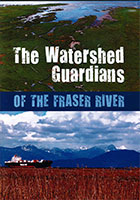
The Watershed Guardians of the Frasier River 2017
Distributed by Green Planet Films, PO Box 247, Corte Madera, CA 94976-0247; 415-377-5471
Produced by Jocelyn Demers
Directed by Jocelyn Demers
DVD, color, 68 min.
General Adult
Pollution, Marine Science, Microplastics, Hazardous Wastes
Date Entered: 12/19/2017
Reviewed by Andrew Jenks, California State University, Long BeachRivers and their watersheds, like the oceans, are the lifeblood of communities. They are essential to commerce, agriculture, recreation, and environmental health, in addition to having an intrinsic aesthetic value. As with so many other environmental resources, they also face increasing pressures, as various constituencies fight for control over the river’s waters. This documentary examines the watershed of British Columbia’s largest river, the Frasier River.
The Frasier River system drains much of the dynamic and beautiful Canadian province of British Columbia. Its main channel is undammed and for that reason boasts some of the most productive runs of salmon in the world – though those runs are down significantly in the last 20 years. One of the biggest challenges facing the river system is the persistent construction of dikes to contain its flow in a single channel. These dikes have stopped the natural tendency of a river to meander as water flows through its channels, depositing rich silt during floods that replenish surrounding farmlands. The infringement of urban life has also restricted the river’s flow, along with dredging to allow the hauling of goods in the river. Farmland transformed into concrete apartments and roads have diminished the capacity of the watershed to retain and absorb water, and also to diffuse fertilizer runoff from farms. Dikes have cut off the river from many of its tributaries and streams, eliminating spawning grounds for salmon and restricting the riparian buffer zones of wetlands between the river and farms that provide drainage and a haven for wildlife.
The story here is a familiar one that illustrates that there is simply not enough river to satisfy the myriad of interests competing for that resource: industry, real estate, indigenous peoples, fisher people, farmers, and recreation. British Columbia’s striking beauty, it turns out, is also the source of its potential demise, as more and more people move into the Frasier river basin. In the competition for scarce resources, the rich and most powerful – large-scale farming, real estate, and industry – seem to be winning the battle for control over the river, and in the process destroying the health and sustainability of the watershed. The documentary offers many solutions for sustainable development, including the maintenance of riparian buffer zones, wetlands, small-scale farming, and the limiting of dikes.